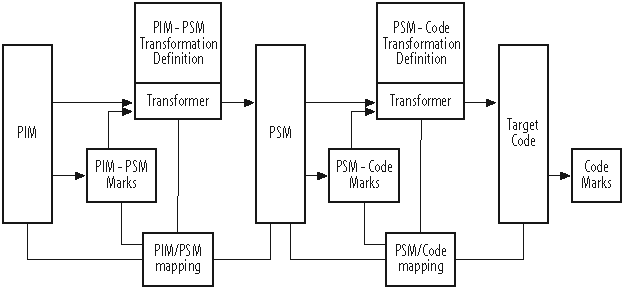Transforming Models
The models up to now provide multiple abstractions of the system. They separate the platform concerns. They trace the origin of each element. These models are static. Transformation functions apply a transformation to a source model to produce a target model. Figure A-4 shows the general case of the transformation function creating or updating target models from the source model and marks. The transformation function, along with the marks and the mappings, are called the bridge between the two principle models.
The mapping model acts in two roles. Before the transformation, it relates the elements of the source models, together with previous versions of the target models. After the transformation, the mapping model traces the source of every target model element created or updated.
During model evolution, transformations at the PIM can cause turmoil in the PSM and code models. Because of the leverage MDA gives, slight refactoring can render the mapping model incapable of reconciling changes. If mappings are recorded by element ID, deleting an element and recreating it risks orphaning it from its marks

Figure A-4. Custom model transformations automate changing abstraction levels
and derivative elements in the target models. If the PSM or code model has a great deal of elaboration, MDA doesn't proscribe a solution to this.
Figure A-4 shows a transformer acting through ...
Get UML 2.0 in a Nutshell now with the O’Reilly learning platform.
O’Reilly members experience books, live events, courses curated by job role, and more from O’Reilly and nearly 200 top publishers.

